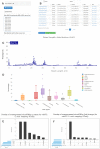sRNAbench and sRNAtoolbox 2019: intuitive fast small RNA profiling and differential expression
- PMID: 31114926
- PMCID: PMC6602500
- DOI: 10.1093/nar/gkz415
sRNAbench and sRNAtoolbox 2019: intuitive fast small RNA profiling and differential expression
Abstract
Since the original publication of sRNAtoolbox in 2015, small RNA research experienced notable advances in different directions. New protocols for small RNA sequencing have become available to address important issues such as adapter ligation bias, PCR amplification artefacts or to include internal controls such as spike-in sequences. New microRNA reference databases were developed with different foci, either prioritizing accuracy (low number of false positives) or completeness (low number of false negatives). Additionally, other small RNA molecules as well as microRNA sequence and length variants (isomiRs) have continued to gain importance. Finally, the number of microRNA sequencing studies deposited in GEO nearly triplicated from 2014 (280) to 2018 (764). These developments imply that fast and easy-to-use tools for expression profiling and subsequent downstream analysis of miRNA-seq data are essential to many researchers. Key features in this sRNAtoolbox release include addition of all major RNA library preparation protocols to sRNAbench and improvements in sRNAde, a tool that summarizes several aspects of small RNA sequencing studies including the detection of consensus differential expression. A special emphasis was put on the user-friendliness of the tools, for instance sRNAbench now supports parallel launching of several jobs to improve reproducibility and user time efficiency.
© The Author(s) 2019. Published by Oxford University Press on behalf of Nucleic Acids Research.
Figures

References
-
- Hayes J., Peruzzi P.P., Lawler S.. MicroRNAs in cancer: biomarkers, functions and therapy. Trends Mol. Med. 2014; 20:460–469. - PubMed
Publication types
MeSH terms
Substances
LinkOut - more resources
Full Text Sources
Other Literature Sources
Molecular Biology Databases

